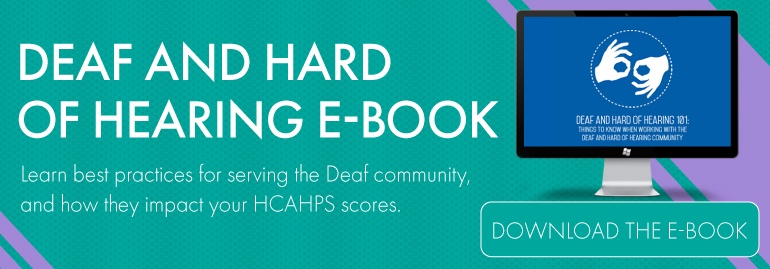
Deaf History Month runs from March 13th through April 15th, commemorating the contributions the Deaf and Hard of Hearing community has made to US society and culture. In honor of Deaf History Month, CyraCom is republishing some of our most popular blog posts on deaf-related topics, including this 2015 piece on using Certified Deaf Interpreters to communicate with Deaf patients:
Certified Deaf Interpreters (CDIs) are interpreters who, while being deaf themselves, have been trained to interpret for deaf patients who may have a limited knowledge of American Sign Language (ASL). If a patient is not fluent in ASL and uses a mixture of gesture/home signs or have a psychological or physical challenge preventing them from using ASL, a CDI would work with an ASL interpreter to facilitate communication between the Deaf patient and the hearing individual.
When CDIs are Necessary
Many people assume that all deaf people are fluent in only ASL. However, depending on the individual’s schooling and their environment, they could have been exposed to ASL, ESL (English Sign Language) or home signs. While of course ASL is the formal language of the Deaf community and has its own distinct syntax and grammar, other variations of communication in the Deaf community have cropped up over the past few hundred years.
So, what about deaf individuals who cannot or choose not to use ASL, such as the Oral Deaf community? These individuals use oral speech to communicate and are sometimes trained to use lip-reading (difficult, with only about 30% accuracy) to communicate. Writing back and forth is also another way of communicating with deaf individuals. Because ASL is a visual language and differs in its syntax and grammar with that of English, writing back and forth can be a challenging way to communicate.
Additionally, Deaf individuals that have recently immigrated to the United States may still use their home countries’ sign language, as well as basic ASL to communicate. Depending on the educational background or sign language exposure, some of these deaf individuals may even use “home signs.”
“Home signs” are signs that have been invented within a household in order to help with deaf communication between hearing and deaf family members. This occurs frequently in hearing families that have one deaf child, since most members of a hearing family never learn ASL. As a result, home signs will differ from family to family. For example, see below for the ASL sign and home sign for “white”.
|
“White” in ASL |
A home sign for “White” |
How Does the Conversation Work?
So how does the deaf interpretation process work if the CDI is Deaf too? In scenarios where a CDI is needed, there will be a total of two interpreters, a hearing ASL interpreter and a Certified Deaf Interpreter, facilitating the conversation between patient and healthcare provider. The ASL interpreter will take the words of the physician and interpret it into ASL for the CDI interpreter, who then takes that information and interprets it for the Deaf patient in a way that they can understand.

1. English speaker to hearing ASL interpreter
2. Hearing ASL interpreter to Certified Deaf Interpreter
3. Certified Deaf Interpreter to patient
The opposite process is the same. The patient will sign to the CDI, who then interprets into ASL for the ASL interpreter. The ASL interpreter then takes that information and interprets it into English for the hearing healthcare provider.

1. Patient to Certified Deaf Interpreter
2. Certified Deaf Interpreter to hearing ASL interpreter
3. Hearing ASL interpreter to English speaker
CDIs are a valuable resource in the event that a Deaf patient does not communicate well in ASL and needs an interpreter. RID (Registry of Interpreters for the Deaf) has a standard practice paper that provides more helpful information on the uses of a CDI and why there are sometimes an essential part of the interpreting role. If you would like to hire a CDI, visit RID’s website or speak with a local ASL agency for more information.
Now that you know a bit more about the role of Certified Deaf Interpreters in providing Deaf interpretation, download our whitepaper for tips on treating Deaf patients in a healthcare setting.













